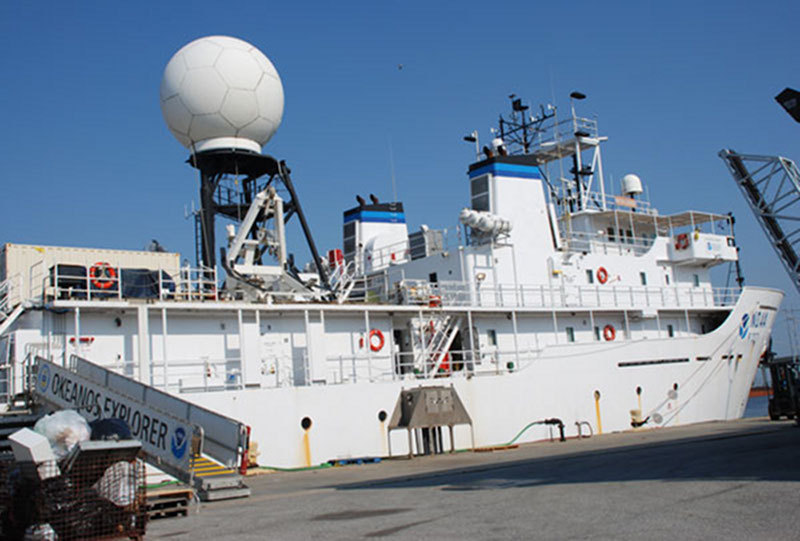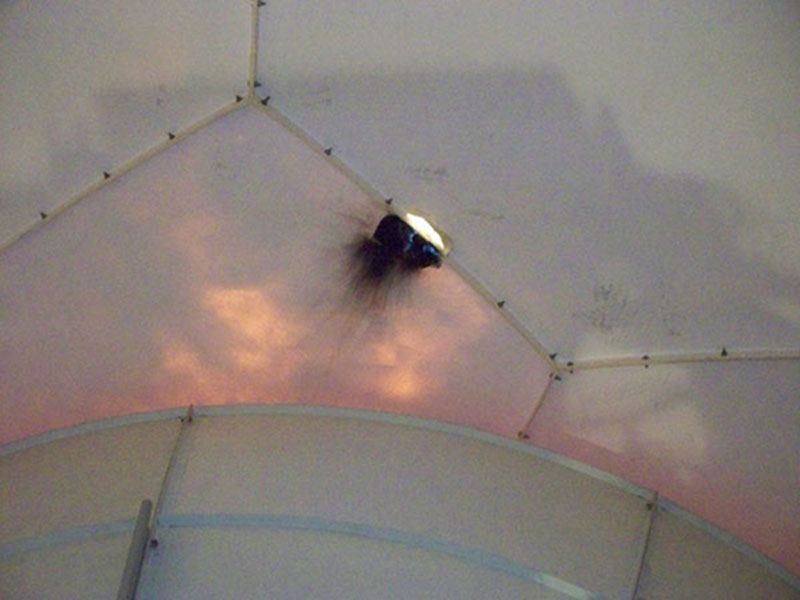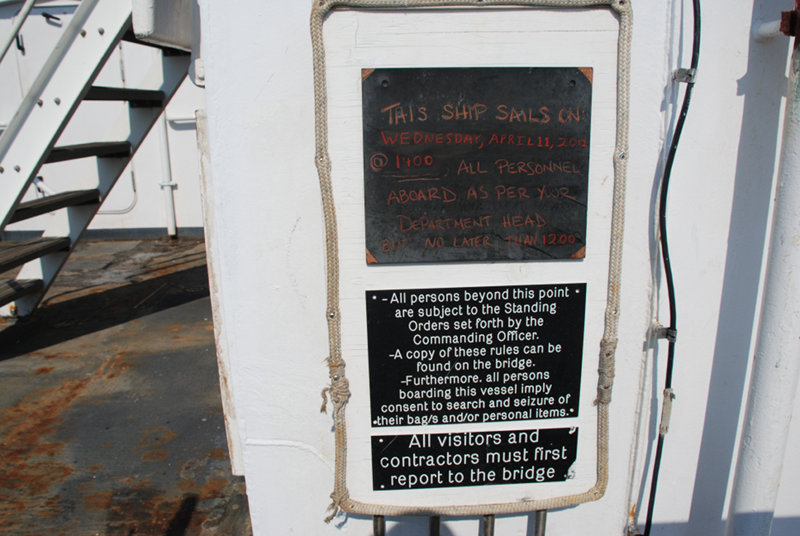
By Court Squires, Web Coordinator - NOAA Office of Ocean Exploration and Research
April 11, 2012

While docked in Pascagoula, Mississippi, the Okeanos Explorer crew ready the ship for the third and final leg of the Gulf of Mexico Expedition. Image courtesy of the NOAA Office of Ocean Exploration and Research, Gulf of Mexico Expedition 2012. Download larger version (jpg, 4.6 MB).
Think of your last road trip. It is likely you poured over maps, plotted your journey (possibly even rerouted it), fueled up, (hopefully) gave the vehicle a check-up, buckled everyone in, and were on your way.

Chief Electronics Technician Richard Conway conducted routine inspections prior to departure and discovered lightning damage (shown here) incurred by the VSAT. Although struck by lightning, the VSAT is usable. Image courtesy of the NOAA Office of Ocean Exploration and Research, Gulf of Mexico Expedition 2012. Download larger version (jpg, 4.0 MB).
Now imagine a 225-foot former Navy ship brimming with scientists, observers, and crew personnel, as everyone prepares to set sail. A little bit more daunting, eh? It could be, but if you break it down you realize preparation is preparation, and those who want to succeed leave no duty, task, or responsibility left unfinished before takeoff.
Checks, double-checks, refinements, and tweaks ushered in April 11, 2012, as the crew of the Okeanos Explorer prepared to depart Pascagoula, Mississippi, for the third and final leg of an exploratory mission in the Northern Gulf of Mexico. The expedition will target seep flux measurements and related acoustic and visual experiments, as well as explore poorly known deep-sea habitats. In layman’s terms, we’re looking for naturally occurring methane gas and conducting related science experiments, and exploring never-before seen areas of the seafloor.
The day began, like every other, with 7 a.m. breakfast in the mess hall. Of course, not everyone was indulging in the blueberry pancakes or crispy bacon because most people had tasks to complete before we left port. (I, however, benefited from said pancakes.)
On the ship, crewmembers walked the perimeter, tending to various duties before leaving port. Outside, Richard Conway, the Chief Electronics Technician, checked for damaged bolts and springs on the VSAT – the ship’s main mode of communication.

A sign at the end of the gang plank leading to the Okeanos Explorer clearly states how to properly proceed on board the vessel. Image courtesy of the NOAA Office of Ocean Exploration and Research, Gulf of Mexico Expedition 2012. Download larger version (jpg, 4.0 MB).
The soccer-ball shaped satellite wasn’t the only equipment on the roster for inspection. Dana Mancinelli, Boatswain Group Leader, tweaked the crane, and engineers swarmed the remotely operated vehicle (ROV) hangar and control room, preparing the ROV Little Hercules for upcoming operations.
Sitting behind engineers Bobby Mohr and Chris Ritter was physical scientist and hydrographer Adam Skarke, methodically reviewing data. Adam explained that prior to plotting out the Okeanos Explorer’s cruise track, he gathers background information such as nautical charts and existing sonar data, then applies it to the planning process.
With all pre-destination duties completed, the ship departed a little after 2:45 p.m., as everyone scrambled toward their respective responsibilities. The shore pulled away from us, growing smaller and smaller, and people disappeared into their workspaces, preparing for the rest of the journey. By nightfall, we were safely out to sea and readying for our first ROV dive of Leg 3.
Just like your average road-trippers, we pulled into our destination, chowed down, bunked up, and prepared for the next day. And just like any well-planned road trip, several explorers had to head to bed early to take the red-eye shift the next morning, sacrificing late-night talks for wee-hour navigation, observation, or maintenance. (No doubt coffee in hand, glazed eyes and all.) And the rest of us headed to bed waiting for the next day of travel and exploration.